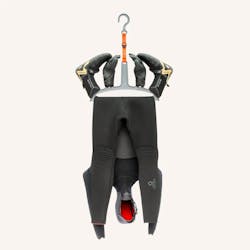How 3D printing can help companies meet ESG goals
As the bleak image of climate change becomes more evident, 3D printing is widely regarded as an important technology for mitigating industry’s environmental impact by producing less waste. Luke Smoothy, founder and director of manufacturing firm Get It Made, looks at how 3D printing is assisting businesses in becoming more sustainable while addressing vital ESG objectives.
As we’re increasingly seeing, sustainability is no longer about companies merely ticking a box; stakeholders and consumers are now demanding more. As organizations focus on their sustainability initiatives through the adoption of a robust ESG (environmental, social and corporate governance) strategy, manufacturers, brands and other organizations must take a holistic approach when reviewing their business and workflow processes, to ensure that they’re delivering end-to-end solutions with a lower environmental footprint.
This is becoming the general consensus, as reflected in HP’s Digital Manufacturing Trends Report, where 88 percent believed it important for governments to create a sustainable ecosystem by incentivizing investment in and development of socially and environmentally beneficial digital manufacturing technologies.
The study also discovered that more than 50 percent of global digital manufacturing and 3D decision makers are interested in learning more about the technology's circularity benefits, which include reducing the number of materials used in production and generating additional value from production systems.
Additive manufacturing (AM) can unlock multiple opportunities for industry, not least its ability to reconfigure value chains through shorter and simpler supply chains, new collaborations, reduced production costs for tools and components and additional design flexibility. The technique also enables decentralized and more localized production by allowing components to be created directly and locally, lowering logistics costs while also lowering carbon emissions.
However, while 3D printing creates opportunities for improving sustainability, the future paves the way for further analysis to find ways of minimizing environmental impact through its use. 3D printing processes, particularly powder-based 3D printing, can have a high energy usage and is not completely waste-free, so it is vital that the industry continues to invest in new ways to make the 3D printing process itself more sustainable.
Case Study: A sustainable solution for C-Monsta
In 2020, Get It Made was asked by C-Monsta to manufacture via its 3D printing capabilities a working prototype to dry wetsuits, fittingly named the Wetsuit Hanger.
The concept of a wetsuit hanger had been in the head of C-Monsta’s founder and director Mark Yeadon, a keen surfer in Scotland. While surfing during winter, the only time of year which saw significant waves, his wetsuit and accessories would often get neglected in the back of a van for days after he removed it, often a habit of surfers. When neoprene (the wetsuit material) isn’t properly dried, it has a distinctive odor, and can lead to the fabric and seams rotting, ultimately limiting the lifespan of the wetsuit.
Yeadon wanted to create a design solution which would not only dry surfing gear faster to prevent bad odors and rot, but also extend its lifespan in order to reduce landfill waste, as neoprene isn’t recyclable. It was the first time he had taken a project from the prototype stage to being mass-manufactured on a large scale.
Yeadon explained: “Before the design of the product could be approved for mass production, our team of project managers undertook the process of curating a working prototype of the component, creating a convenient drying tool for those who are bold enough to brave cold waters.”
Describing the process of creating a prototype for his company’s product, he said: “Although I love problem-solving, this was the first time I had worked on designing and manufacturing a product. I had gotten to a point where I had designed and proved the concept but could not find a way to manufacture it economically. I was given a grant to work with a designer at the Glasgow School of Art, where my idea was refined and modeled for injection molding. We ran out of time on the project before completing the design, and I couldn't afford to pay for the design to be completed, so I rolled up my sleeves and worked out how to use Fusion 360 to finish the modeling process on my own. I then required a 3D printed model, which is where Get It Made stepped in. Traditional prototyping methodologies including production runs and injection molding can be costly as they require a lot of human labor, whereas 3D printing doesn’t. Additive manufacturing also creates less waste, and only uses the material that is needed to create a prototype part.”
He is already seeing the tangible benefits brought by 3D printing: “Using my prototype, my wetsuit lifespan lasted two winters instead of one, saving me $450 every two years. It is a low-tech solution with a relatively high impact on kit maintenance and lifespan. The aim is for the entirety of the wetsuit hanger to be made from recycled plastics, as C-Monsta bids to leave behind the smallest carbon footprint possible, underlining the importance we place upon sustainability within the business.”
About Luke Smoothy
Luke Smoothy founded Get It Made in 2011 with just £200 [about $253], initially as a side-hustle alongside his job as a furniture designer. After experiencing first-hand how difficult manufacturing can be, he was driven by a mission to make manufacturing simple and find a better solution for designers and engineers everywhere. Today, the London-based company is a multimillion-pound-a-year business and an ISO 9001-accredited manufacturer, providing manufacturing services to companies across the globe. By removing risk and adding specialist expertise to the manufacturing process, Get It Made has steadily grown to become a 3D printing, CNC machining, injection molding and aluminum extrusion expert.
Smoothy has worked on thousands of complex projects for customers across various disciplines including aerospace, medical and R&D. He has worked with companies such as Hitachi, Airbus and Stanley as well as institutions such as the Imperial College of London.


